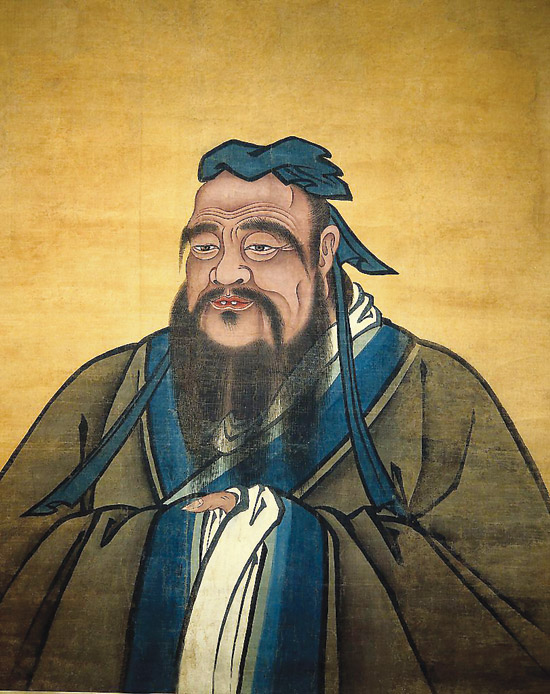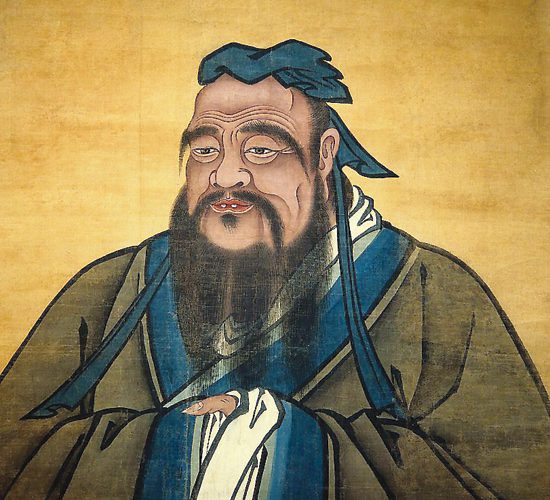(No.8, Vol.2, August 2012 Vietnam Heritage Magazine)
From The Three Teachings of Vietnam, As an Ideological Precondition for the Foundation of Caodaism, Hue Khai, Religion Publishing House, Hanoi, 2010. (Whatever Caodaism may have owed to Confucianism, the present article is interesting in relation to the history of Confucianism, a religion often cited as having had an important influence on Vietnam as the country appears today. – Ed.)
Confucianism was brought into Vietnam under Chinese rule, through three periods, from 111 BC to 39 AD, by the Western Han and Eastern Han dynasties, from 43 AD to 541AD, by the Eastern Han, Three Kingdoms, Jin and Northern and Southern dynasties and from 602AD to 905AD, by the Sui and Tang dynasties.

Confucius
During the first ten centuries AD, Vietnamese Confucianism learning did not flourish. Monks learnt Chinese characters to read Buddhist s?tras and absorbed Confucian teaching. When the nation gained independence from China in the 10th century AD, under the Ngo (939-967), Dinh (968-980) and Le (980-1009) dynasties, the elites supporting the imperial court were Daoist priests and Buddhist monks. Monks taught Ly Cong Uan (974-1028), who later became the founder of the Ly dynasty (i.e., Ly Thai To, reign 1009-1028). Under the reign of King Ly Anh Tong (1138-1175), monk Tri, from Mount Cao Da, taught Thái Úy (Defender-in-Chief), To Hien Thanh (?-1199) and Thái B?o (Assistant Grand Tutor) Ngo Hoa Nghia.
Vietnamese Confucian learning developed from the 11th century, and gradually declined under the Nguyen dynasty (1802-1945). Confucian learning qualified the literati to be court officials via civil-service examinations. Many Vietnamese Confucian scholars were also authors who studied Confucian philosophy. In war and its aftermath books were taken and destroyed. Almost nothing was left for later ages to study. Maybe the prominence of Vietnamese Confucianism is not so much due to philosophical thoughts as to literature, a civil-service examination system and the political role of Confucian scholars. In 1070, King Ly Thanh Tong (reign 1054-1072) had the V?n Mi?u (Literature Temple) built, in which the statues of the Duke of Zhou, Confucius, and the Seventy-Two Worthies were worshipped.1 In 1075, King Ly Nhan Tong (reign 1072-1127) opened the first civil-service exam, called Tam Tr??ng (Three-Round Exam), in which the best candidate was Le Van Thinh. The King also set up Qu?c T? Giám (the Imperial College) in 1076 and Hàn Lâm Vi?n (the Imperial Academy), and chose Mac Hien Tich as an Academician.2 Noted Confucian scholars under the Ly dynasty were Ly Dao Thanh (?-1081), Truong Ba Ngoc and To Hien Thanh (?-1179).
King Tran Thai Tong (reign 1226-1258) opened such exams as the Thái H?c Sinh (High College Student Exam) in 1232, the Tam Giáo (Three-Teaching Exam) in 1247, and the Tam Khôi (Three-Degree Exam) in 1247 to select Tr?ng Nguyên (the First Degree), B?ng Nhãn (the Second Degree), and Thám Hoa (the Third Degree). In that exam, Le Van Huu (1230-1322) got B?ng Nhãn (the Second Degree) and later became the historian who wrote ??i Vi?t S? Ký (A History of Great Vi?t). The King also set up Qu?c H?c Vi?n (the Institute of National Learning) in 1253 to teach Sishu (the Four Books) and Wujing (the Five Classics). 3


A Confucian teacher and his students; On the king’s behalf, the chief of Nam ??nh Province banqueting successful candidates (1897);
Photos: The Three Teachings of Vietnam, As an Ideological Precondition for the Foundation of Caodaism, Hue Khai
Under the reign of King Tran Due Tong (1373-1377), the Thái H?c Sinh Exam was renamed as the Ti?n S? (Advanced Scholar Exam) in 1374.4 Under the reign of King Tran Thuan Tong (1388-1398), Le Quy Ly (1336-1407) wrote a book titled Minh ??o (Explaining the Dao), in 1392, then translated the chapter Wuyi (Against Luxurious Ease) of Shujing (the Book of Documents), in 1394, to teach the crown prince, and Shijing (the Book of Songs), in 1396 to teach inner-palace women.

Candidates and proctors inside an examination site (a drawing made in 1895)
Under the Tr?n dynasty, civil-service exams helped to develop literature. Noted Confucian scholars included Mac Dinh Chi (1280-1346); Nguyen Trung Ngan (1289-1370) with Gi?i Hiên Toàn T?p (Gi?i Hiên’s Complete Works); Truong Han Sieu (?-1354); Chu An (1292-1370) with T? Th? Thuy?t ??c (Concise Explanation of the Four Books), and Ti?u ?n Qu?c Ng? Thi (Ti?u ?n’s Poems in the Nôm Script); Pham Su Manh (Chu An’s student) with Hi?p Th?ch T?p (Hi?p Th?ch’s Collected Works); Han Thuyen (or Nguyen Thuyen) with Phi Sa T?p (Phi Sa’s Collected Works). What does the word ‘with’ mean in this paragraph? It appears four times. It means who wrote Le Quy Ly (1336–1407), also known as Ho Quy Ly, overthrew the Tran Dynasty and set up the Ho Dynasty. Chinese Ming aggressors robbed the national archives and took material to Jinling (Nanjing). They burnt whatever they could not take away, causing a terrible loss to Vietnamese culture. Under Ming aggression, Neo-Confucianism was brought into Vietnam.5 Under the later Le Dynasty, Confucian learning was highly valued as qu?c h?c (national learning). Civil-service exams helped to increase the intelligentsia. In the capital there were the Qu?c T? Giám (the Imperial College) and the Thái H?c Vi?n (High College). King Le Thanh Tong divided the territory into thirteen ??o (circuits). In most of the circuits on the plains, public schools were set up; and exam regulations were also imposed. In 1463 about 1,400 candidates took the Metropolitan Exam (thi h?i) and in 1475, the number of candidates mounted to 3,000. From the Le Dynasty on, high honours were bestowed on successful candidates: ceremonies announcing advanced scholars’ names (l? x??ng danh), taking them to their native villages (l? vinh quy, literally, glorious return ceremony), and inscribing their names on stelae housed at the Literature Temple.
Noted Confucian scholars under the Le Dynasty included Nguyen Trai (1380-1442), Le Van Linh, Bui Cam Ho, Nguyen Thien Tich, Nguyen Truc (1417-1474), Nguyen Nhu Do (1424-1526), Luong The Vinh (1442-?), Do Nhuan, Than Nhan Trung, Luong Dac Bang (1472-1522), Nguyen Binh Khiem (1491-1585), Phung Khac Khoan (1528-1613), Luong Huy Khanh, Nguyen Du, Giap Hai (1515?-1585?), Nguyen Mau Nghi, Pham Cong Tru (1600-1675), Le Anh Tuan, Nguyen Cong Hang, Pham Dinh Trong, Le Quy Don (1726-1784), Ly Tu Tan (1378-?), Nguyen Mong Tuan, Phan Phu Tien (1370?-?), Ngo Si Lien. After defeating the Chinese Ching invaders in 1789, King Quang Trung (reign 1788-1792) set up the Sùng Chính Vi?n (the Institute of Governance Veneration) and appointed La Son Phu Tu Nguyen Thiep (1723-1804) head, whose important duty was to reform Vietnamese Confucian learning. La Son Phu Tu finished translating Xiaoxue (Small Learning), Sishu (the Four Books) and Wujing (the Five Classics) into the Nôm script. King Quang Trung died prematurely, leaving his reform program unaccomplished.
The learning bound up with civil-service exams declined gradually. The French conquered Vietnam and introduced European learning. Finally, the exams based on Confucian learning terminated in the North in 1915 and in Central Vietnam in 1918. The termination was earlier in the South, after the French colonialists took up occupancy of the whole of Cochinchina in the years 1862 to 1867.n
1 Tran Trong Kim 1971b: 99; 2 Tran Trong Kim 1971b: 101; 3 Tran Trong Kim 1971b: 124; 4 Tran Trong Kim 1971b: 124; 5 Tran Trong Kim 1971b: 212.


Successful candidates in academic costumes conferred by the king; Successful candidates’ names on stelae housed at the Literature Temple; Successful candidates kowtowing before the Literature Temple (1897).
Photos: The Three Teachings of Vietnam, As an Ideological Precondition for the Foundation of Caodaism, Hue Khai

